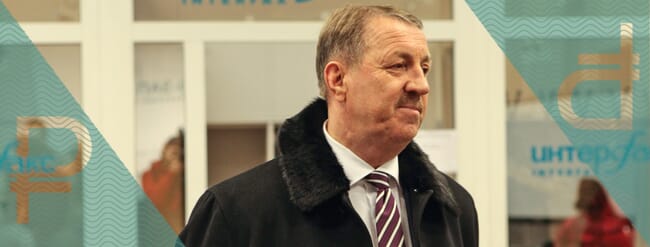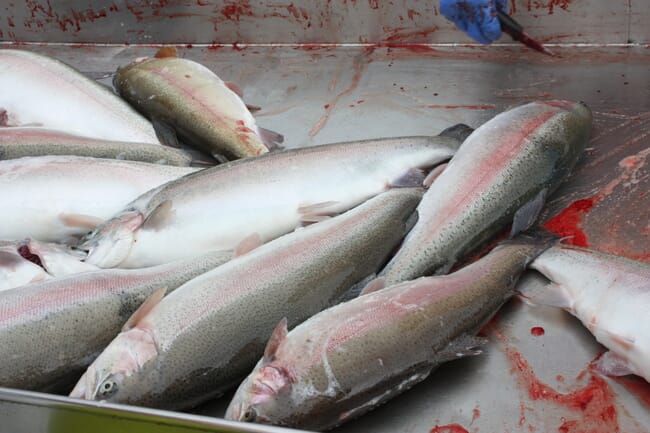Russian billionaire Andrey Katkov has announced plans to invest in trout and salmon production in north-west Russia. Katkov, who is the owner of Judo Yavara-Neva, one of the largest networks of judo clubs in Russia, and a former sparring partner of Vladimir Putin, is diversifying into aquaculture by building a land-based trout and salmon farm in the St Petersburg region.

According to an official spokesman for the businessman and the St Petersburg officials, the project’s implementation will be carried out by Aquatrade, a company majority owned by Katkov. According to some Russian aquaculture analysts, although it hasn’t yet been announced which species it will be stocking, the farm is likely to focus on rainbow trout production, due to high demand for the species in cities such as St Petersburg and Moscow – also, it is easier to source rainbow trout stock than Atlantic salmon in Russia.
However, the operation may also include the production of some sockeye and chum salmon and at the initial stage will have the capacity to produce about 2,000 tonnes of fish per year. This will make it one of the largest salmonid farming operations in Russia.
The project will require an estimated US$40 million investment – most of which will be self-financed, while the remainder will be provided by local bank loans.
Boris Shevelev, general director of Aquatrade, said that the entire complex will be located on a 42-hectare site. He also added that the project’s implementation will be carried out in three stages, the first of which will be completed in 2021; the third phase will be finished by 2023, when the complex will reach capacity. The new farm will be vertically integrated, taking the fish from eggs to finished consumer products, and construction work on the RAS is already underway.

Shevelev says that all its products will be delivered to Russia’s largest federal retail chains, particularly those with a large presence in Moscow and St Petersburg. The company may, however, consider exporting too. Meanwhile most of the feed ingredients, according to the company, will be imported, from countries including Denmark and South Africa.
Experts from the Russian Ministry of Agriculture, as well as the Russian Federal Agency for Fishery (Rosrybolovstvo), believe that Katkov’s project could have a strategic importance for the entire Russian aquaculture industry, as its development has significantly slowed down after several years of consecutive growth.
According to an official spokesman for Ilya Shestakov, head of Rosrybolovstvo, at present Russia has a shortage of industrial-scale RAS farms. This is mainly due to the long payback periods involved in such projects, despite the fact they tend to minimise fish losses.
While carp continues to dominate Russia’s aquaculture sector, the St Petersburg and Karelia regions have traditionally focused on salmonid production. Rosrybolovstvo analysts expect Aquatrade to become one of the largest producers of salmonids in the north-west and to compete with the current market leaders – Russian Sea Aquaculture and Russian Salmon. Moreover, they note that the company has a good chance to become the biggest producer in the St Petersburg region, as most of its major competitors are concentrated around Murmansk.
Prior to the introduction of trade embargos, up to 80 percent of the Russian salmonid market was made up of imports, primarily from Norway. However, the embargo has provided a major impetus for the development of aquaculture in Russia and led to the launch of several large-scale salmonid farming projects.
Despite the typically long payback periods, in recent years salmonid production has attracted considerable interest from Russian business. And, according to experts of the Russian Ministry of Agriculture, the market for salmonids remains very promising, with domestic demand growing by 25 to 30 percent a year – quite possibly the highest growth rate in Europe.
At present the largest producer of salmon and trout in the Russian market is PJSC Russian Aquaculture, which is owned by the brother of Maksim Vorobiev, Moscow’s regional governor. In the first half of 2018, its share in the Russian market of salmon aquaculture, according to its own data, was 22 percent and it has the capacity to produce 18,000 tonnes a year.
In regard to salmon consumption, according to figures from the All-Russian Association of Fish Breeders, Entrepreneurs and Exporters (a public association, which unites leading Russian fish and aquaculture producers), the consumption of salmon in Russia last year reached 339,000 tonnes. While substantial, it is still lower than the 500,000 tonnes being consumed before the imposition of sanctions against Russia in 2014, which resulted in a significant drop in the purchasing power of local consumers and a decline in the consumption of salmonids in the country.
By 2015-2016 salmon consumption had fallen by around 40 percent, to between 280,000 and 300,000 tonnes. And the situation was significantly complicated by the introduction of a ban on the import of salmon from Norway and its replacement by more expensive imports from the Faroe Islands and Chile.
The situation in the market has started to improve only since the second half of 2017, due to stabilisation of the economic situation in Russia and the launch of several domestic salmon production projects.


